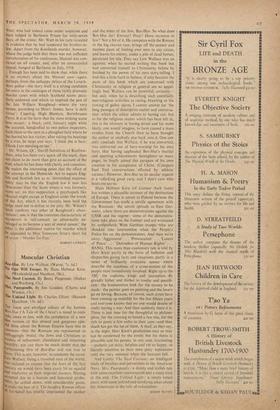Dark Virtue
The Trial of Peter Manuel. By John Gray Wilson. (Seeker and Warburg, 21s.) ON January 2, 1956, a girl called Anne Kneilands was battered to death with a piece of iron near the golf-course at East Kilbride, Lanarkshire. Certain evidence pointed to Peter Manuel, a twenty-nine- year-old Gas Board worker with an extensive criminal record; the police examined some of his belongings, an identification parade was held and Manuel's photograph appeared, after an interview with a reporter, in the Scottish Daily Express of January 14. Two years (including fourteen months in prison on a housebreaking charge) and at least eight murders later, Manuel was arrested. It is likely that he had killed three other people, thus bringing the known total to twelve.
By the time that he was tried in May, 1958, he had made elaborate confessions to the eight mur- ders with which he was charged, and which had all occurred in an area six miles by four in the south-east suburbs of Glasgow; and, there being no evidence, other than the crimes themselves, of mental abnormality, virtually his only chance of acquittal was to exclude evidence of the confes- sions as inadmissible, the suggestion being that they were induced in return for a police under- taking to help Manuel's father. This failed; where- upon Manuel dismissed his counsel and conducted the rest of his defence himself, with a skill to which the judge paid sober tribute, although his remain- ing explanation—that the whole affair was a gigantic police plot against himself—was not a persuasive one. One of the two triple murder charges was that of the Watt family; Mrs. Watt, her sister and daughter had been shot in bed in September, 1956. To this charge Manuel pleaded the special defence of impeachment, not heard in a murder case since 1862, whereby he accused Mr. Watt, who had indeed come under suspicion and been lodged in Barlinnie Prison for sixty-seven days, of the crime; Mr. Watt in his turn revealed in evidence that he had suspected his brother-in- law. Apart from the Kneilands murder, however, Where the judge held that there was not sufficient corroboration of his confession, Manuel was con- victed on all counts, and, after an unsuccessful appeal, hanged at Barlinnie in July, 1958.
Enough has been said to show that, while there Is no mystery about the Manuel case—apart, Perhaps, from the unhappy delays of the Lanark- shire police—the story itself is a strong candidate I or entry in the catalogue of those richly dramatic murder cases with which Scotland seems pecu- liarly endowed and which so inspired the pen of the late William Roughead—where the very names, according to Henry James, have 'a dark virtue': CapeIrig. High Blantyre, Burntbroom Farm. It is at the farm that the most striking scene here occurs : a black, ,cold, January night while the accused, handcuffed to two police inspectors, leads them to the spot in a ploughed field where he has buried his last victim; after taking his bearings by a tree, he stops and says, 'I think. she is here; I think I am standing on her.'
Mr. Wilson, QC, Sheriff-Substitute of Renfrew- shire, who has been very quick off the mark, does not claim to do more than give an account of the trial, which he has done with clarity and concision. fie makes the interesting point that the effect of the attempt in the Homicide Act to equate Eng- lish and Scottish law as to 'diminished responsi- bility' may be that the 'English law is now less Draconian than the Scots where it was formerly More so'; on this supposition a psychopath like Manuel might escape in England under the words (,)f the Act, which it has recently been held the Judge need not re-define to the jury. Mr. Wilson's book confirms two other of Roughead's obser- vations: one is that the common characteristic of Murderers is 'self-conceit, so abnormally de- veloped as to become a sort of moral cancer,' the Other is the additional motive for murder which he appended to Miss Tennyson Jesse's short list of scycn---'M urder for Fun.'
ROBERT LINDLEY



































 Previous page
Previous page